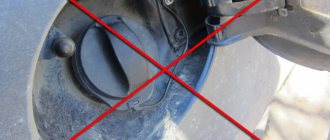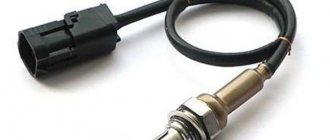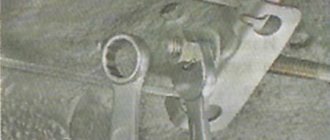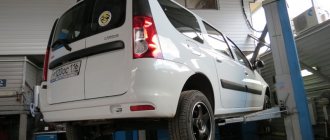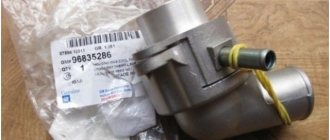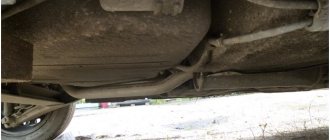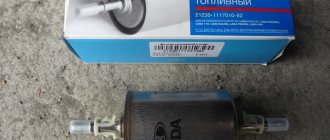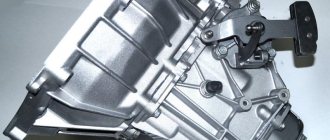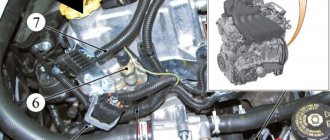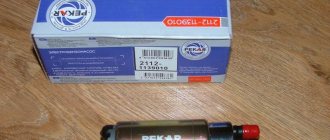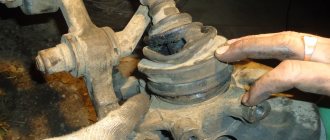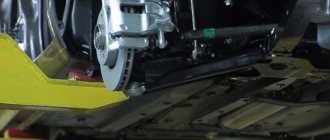The fuel pump of the Lada Granta car is equipped with electric submersible fuel pumps. The pump supplies and circulates the mixture in the fuel system. Recently, the car has been equipped with an electric submersible fuel pump from the Bosch brand. This device has the following characteristics:
- rated voltage - 13.5V, operating - in the range from 6 to 15 volts;
- maximum volume of pumped mixture
- the frequency of replacing the fuel filter is 1000 operating hours;
- range of fuel classes: AI-92 - AI-95.
Repair
Repair of a mechanical fuel pump Repair
of a mechanical fuel pump consists of installing a new repair kit (diaphragm and valves) and, if necessary, a worn pusher with a spring. A deeper repair of this device is impractical, since the costs of purchasing and repairing worn parts are close to the cost of a new product. If the pump housing is deformed or damaged, it must be completely replaced.
Electric fuel pump repair
The electric fuel pump is equipped with a non-separable housing, and if it breaks down, the product is replaced with a new one. Without special skills, equipment and spare parts, opening and repairing it is impossible. But some workshops undertake similar work, the price of which is lower than buying a new pump. The main failures of the device are as follows:
- Damage to brushes and motor commutator. Repair involves replacing them with new ones.
- Breakage of the plastic coupling connecting the rotor and the motor armature shaft. The clutch is replaced with a new one.
- Anchor failure. The repair involves rewinding this part.
The described actions allow us to eliminate the gas pump malfunction on all models of the VAZ: 2101, 2102, 2103, 2104, 2105, 2106, 2107, 2108, 2109, 21099, 2110, 2111, 2112, 2113, 2114, Niva, Priora, Kalina, Grant, Vesta and most foreign cars.
Removing and disassembling the Lada Granta fuel module
Tools:
- Open-end wrench 10 mm
- Medium Phillips screwdriver
- Medium flat screwdriver
- Small hammer
- Pliers
- Side cutters
Parts and consumables:
- Clamp for fastening the corrugated fuel supply pipe to the pump fitting
- Fuel pump (replacement if necessary)
- Strainer retaining washer (replacement if necessary)
- Engine oil
- Rags
Notes:
The work is performed to clean the strainer, replace the fuel level sensor, fuel pressure regulator or fuel pump.
1. Relieve pressure in the power system as described here.
2. Disconnect the wire terminal from the negative terminal of the battery as described here.
3. Inside the vehicle, remove the rear seat cushion as described here.
4. Bend down the soundproofing flap located under the seat cushion.
5. Unscrew the four screws securing the fuel module hatch cover and remove it.
6. By releasing the clamp of the wiring harness block, disconnect the block from the fuel module connector.
7. Remove the fuel hoses from the fuel pump cover, which are secured with clips (see first photo). Use one screwdriver to press the latch on one side. Using another screwdriver, pry the fuel hose in the direction of the arrow and remove it.
8. Wipe the pump with a rag.
9. Remove the retaining ring using screwdrivers and a hammer. The arrows in the first photo indicate the direction of torsion. The system of "pits" and "grooves" makes it easier to remove the retaining ring.
Note:
As soon as you loosen the ring, some gasoline will flow out (this is normal).
10. Carefully, being careful not to damage the fuel level indicator sensor float, remove the fuel module from the tank.
11. Remove the rubber gasket.
12. Cover the opening in the fuel tank with cloth or cardboard to prevent foreign objects from getting into it. Disconnect the ground wire terminal from the slip ring terminal on the fuel pressure regulator housing.
13. Press the antennae of the fuel pressure regulator mounting bracket on both sides and remove it.
14. Remove the slip ring (if equipped) from the regulator body. The photo below shows fuel pressure regulators with a removable slip ring and a contact soldered to the regulator body.
15. Using pliers, remove the fuel pressure regulator from the module cover socket.
Note:
The regulator connections are sealed with two rubber rings.
16. Using a slotted screwdriver, press the latch (indicated by an arrow in the photo) of the wire block and disconnect it from the cover connector. Similarly, disconnect the wire block from the fuel pump connector.
17. Using your fingers, press out the upper latches of the fuel level indicator sensor and slide the sensor along the grooves of the module cup.
18. Remove the fuel level indicator sensor assembly with the float, wires and wire blocks.
19. Carefully press out the three plastic clips and remove the lower glass.
20. Use a slotted screwdriver to pry and remove the strainer.
21. Remove the lock washer from the slot in the strainer housing.
22. Having pressed the latch (indicated by a red arrow), remove the fuel pump from the holder, and also use side cutters to cut the clamp securing the corrugated fuel supply tube (indicated by a blue arrow).
23. Heat the corrugated tube (you can pour boiling water on it) and remove the tube from the pump fitting.
24. Using a slotted screwdriver, push the tip of the fuel drain tube out of the socket in the glass.
25. A valve is installed in the fuel module cup to prevent fuel from leaking out.
26. Assemble and install the fuel module in the reverse order
When installing the strainer, pay attention to the condition of its lock washer (item 21). If the lock washer is dented, it must be straightened or replaced.
If the lock washer is dented, it must be straightened or replaced.
27. Replace the clamp securing the corrugated fuel supply pipe to the pump fitting with a new one.
28. Before installing the fuel pressure regulator, apply a thin layer of engine oil to its O-rings.
29. When installing the fuel module into the tank, arrow 1 on the fuel module cover should be directed back (towards the trunk). Arrows 2 on the bosses of the cover fittings indicate the direction of fuel movement.
30. Place the tips of the fuel pipes onto the fittings of the module cover until the spring clips click.
31. Having connected the wire terminal to the “negative” terminal of the battery, start the engine and check the tightness of the connections of the fuel pipes.
The article is missing:
- Photo of the instrument
- Photos of parts and consumables
Specifications
How to change the ignition switch on a Daewoo Nexia: photos and videos
The composition of power units on the domestic market for the crossover has not changed. The base Lexus RX is equipped with an inline two-liter turbocharged four that produces 238 horsepower and 350 Nm of thrust. It is mated with a hydromechanical automatic transmission, as well as front-wheel drive or all-wheel drive. Acceleration from zero to hundreds will take 9.2-9.5 seconds, maximum speed is 200 km/h, and fuel consumption is 7.8-7.9 liters per hundred in the combined cycle. For an additional fee, you can order a 3.5-liter V-shaped naturally aspirated six with 300 horses and 370 Nm. It has the same transmission and exclusively all-wheel drive. In this configuration, the car reaches 100 km/h in 7.9 seconds, develops 198 km/h and consumes 10.7 liters. The older trim levels will receive a hybrid power plant. It is based on a similar V6 with reduced performance and an electric motor. This tandem develops a maximum of 263 hp and 335 Nm. The hybrid version accelerates to hundreds in 7.7 seconds, reaches a maximum speed of 200 km/h and consumes 5.2 liters in the same mode.
Engine Lada Granta
Replacing the cabin filter on the Lada Granta: video instructions
If the engine power of a Lada Granta car drops, increased noise occurs, or whines are periodically heard when the fuel pump is operating, then most likely the fuel pump has failed. First, check the pressure in the fuel supply system by connecting a pressure gauge to the fitting on the fuel rail in the engine compartment. If the pressure in the power system is higher than 400 kPa (4.0 kgf/cmg), then the pressure regulator installed in the fuel pump module is faulty and must be replaced (see “Repairing the fuel module of Lada Granta.”) If the pressure in the power system is lower 380 kPa (3.8 kgf/cmg), replace the fuel filter (If this does not help, try removing the module and washing its receiver screen.
If in this case the pressure does not increase, the fuel pump must be replaced.
Causes of clogged strainer on Grant
It is not necessary to change the grid so often, since when refueling with normal fuel, it can easily travel more than 100,000 km. But symptoms may appear that indicate a clogged fuel pump mesh:
- poor engine start
- insufficient pressure in the fuel system
- dips when pressing the gas pedal
- the engine began to slowly gain speed
If you begin to notice the problems described above, then the first thing you should do is look at the mesh filter and, if necessary, replace it.
The fuel pump does not pump: causes and diagnostics
Parameters and technical characteristics of the Lada Granta. Lada Granta VAZ 219010. Lada Granta model 219010
Let's start with the fact that if the gas tank is full, the battery is charged, the spark plugs are dry and there is a spark, the starter turns the engine normally, but the engine does not seize, then you should pay attention to the gas pump. A common problem is that there is no power to the fuel pump after the ignition is turned on. In a similar way, the malfunction manifests itself in motion, when the power to the fuel pump is lost and the engine suddenly stalls.
In a similar way, the malfunction manifests itself in motion, when the power to the fuel pump is lost and the engine suddenly stalls.
An equally important point is how much the fuel pump pumps. In other words, the pump may hum and buzz (power is being supplied), but not create the required pressure in the fuel line. The pressure in the fuel system with a working fuel pump must be more than 3 bar (which depends on the specific car model). The indicated pressure is accumulated in the fuel rail and has an indicator of 300 kPa and above.
To check, you need to measure the pressure in the fuel rail with a pressure gauge, taking into account the indicators that are the norm for a specific car model. Using the example of injection VAZs, the pressure when the ignition is turned on is 3 atmospheres, at idle the figure is 2.5 atmospheres, when you press the gas 2.5-3 atmospheres. This method will help you accurately determine:
- malfunction of the fuel pressure regulator in the rail;
- breakdown of the fuel pump or a noticeable decrease in its performance due to wear;
- severe contamination of filters (fuel filter and/or fuel pump mesh);
In the second case, when you press the gas, the pressure does not increase; in the latter case, the pressure gauge needle rises, but very slowly or jerkily.
A decrease in pressure below the norm will lead to the fact that the engine may not start or start with difficulty, stall, jerk, operate unstably and with failures. If this happens due to the fault of the pump and not the fuel filter, then there is a high probability that the coarse filter screen of the fuel pump is clogged. In this case, there is no need to change the fuel pump itself, since it will be enough to replace or even clean the mesh.
If you suspect that there is no voltage to the fuel pump, there is a quick way to check. It is enough to turn the ignition key and listen, as when you turn the key you should hear a slight hum from the fuel pump. If such a buzzing noise is not heard, it means there is no power to the fuel pump, there are problems with the wiring, etc.
We add that this method of determining the operation of the pump by sound is not suitable for all cars. On some models (especially premium ones), sound insulation is at a high level and the fuel pump turns on immediately after opening the driver's door, and not when turning the key in the lock. In this case, it may seem that the fuel pump does not work when the ignition is turned on, and the sound of the pump may simply not be heard.
Also in the general list of possible reasons why the fuel pump does not pump, the following are noted:
- failure of the fuel pump fuse;
- fuel pump relay failure;
- problems with the ground of the fuel pump;
- malfunction of the electric motor of the fuel pump;
- oxidation or damage to fuel pump contacts and terminals;
- the fuel pump itself is faulty;
Operating principle and specific purpose of the filter
Any car, regardless of its design, has a fuel filter. (pictured is a fuel filter on a VAZ-2115)
Naturally, it differs in terms of fuel type and its supply to the car. But still, there is a filter. In the case of the Lada Granta car, this is a traditional filter element used everywhere in injection-type cars.
The main task of such a filter is to catch and sift out particles of dust, rust and other inclusions so that they do not penetrate into the fuel line. If such a filter did not exist, the motor would very quickly fail, since a lot of solid particles that could damage the cylinder walls would get into it.
The filtration system has an established principle of operation, which involves two degrees of purification. The first stage involves catching the largest contaminants, followed by the second stage of fine cleaning, which is usually called a fuel filter in the traditional sense of the word.
Fuel filter cross-section
Fuel filter from Granta in a section (removed from the car, not new)
But it must be located in front of the engine and after the fuel tank.
Given the increased pressure in the fuel line, the filter must be made of metal or high-strength plastic.
Which fuel filter should I choose?
As you know, all variations of the Lada Grant are equipped with an engine with the same displacement of 1.6 liters. The differences are only in the power that this power unit can produce.
This injection engine, unlike its “carburetor counterparts,” requires a much greater degree of cleaning. So, many experts recommend not stopping at the basic recommendations for a purification degree of 10 microns, but turning to a more significant level of filtration that would guarantee the retention of solid particles with a size of 5 microns. The operating pressure, in the case of the Lada Granta, will vary between 3 and 5 bar.
When to change the fuel filter?
And, of course, you need to say a few words about when exactly it is appropriate to replace the fuel filter.
On average, a fuel filter loses its characteristics closer to 25 thousand kilometers. But this applies to optimal conditions when the highest quality gasoline is used. In reality, the need for replacement may occur earlier.
Signs of a dirty fuel filter
To find out exactly when you need to replace the fuel filter on your Lada Granta, you need to monitor the main signs of its contamination.
- This usually concerns the engine starting, which will be uneven and delayed.
- Next comes insufficient traction.
- And, with sharp acceleration, the power unit can even stall.
- As for idling, if the filter is dirty, it will be uneven.
Of course, some of these “symptoms” are also typical for problems with the air filter or injectors. But, in any case, this is already a sign that it is necessary to begin a thorough check of the fuel filter, and, if necessary, replace it with a new one.
All by yourself - Replacing a VAZ fuel pump with a Lada Granta
The main symptoms of a faulty VAZ fuel pump on a Lada Granta car are a drop in pressure in the fuel system, and as a result of this, the car moves jerkily and the engine cannot be spun up to maximum speed. Also, if you hear uncharacteristic sounds in the area of the rear seats, similar to a short-term howl, then most likely it’s time to repair the car, namely, replace the fuel pump of your Grant.
Procedure for replacing a VAZ fuel pump on a Lada Granta
1. Open the fuse mounting block, which is located on the dashboard to the left of the driver’s seat, and take out the element we need, which is responsible for the fuel pump. 2. Lift and remove the rear seat sofa, then remove the trim underneath it 3. There is a black hatch on the right side. Under its cover there is access to the fuel pump 4. Using a Phillips screwdriver, unscrew the four screws and remove the hatch cover 5. After accessing the fuel pump, disconnect the power terminal and pipelines. 6. Using a hammer and screwdriver, unscrew the locking ring counterclockwise, which secures the fuel pump in the car tank. 7. Having removed dust and dirt from the area of the upper part of the fuel pump using a rag, carefully remove it and replace it. 8. Reassemble in reverse order
Replacing the mesh and cleaning the fuel pump
1. After the plastic cup of the fuel pump has been removed from the gas tank, carefully unsnap the four plastic latches and remove the lower part of the cup 2. As a rule, there will be a huge amount of dirty deposits in the cup, and the mesh will be completely covered with dirt. 3. Using a screwdriver, remove the screen and thoroughly clean all parts of the fuel pump. 4. We install a new mesh (coarse filter), assemble and install the fuel pump in the tank.
vse-sam.com.ua
Cleaning the part
Replacing the Lada Granta fuel pump in some cases is not the only way to get rid of fuel supply problems in some cases. To restore the functionality of the fuel pump, it requires thorough cleaning. To do this, you need to dismantle the unit using the method described above.
Next, unscrew the lower part of the fuel pump cup. The glass has a filter mesh that needs to be removed using a screwdriver. The mesh will need to be cleaned with a rag and rinsed in solvent. After this, the remaining elements of the fuel pump are cleaned.
After cleaning is completed, it is recommended to install a new coarse mesh, as the cells on the old one may be damaged.
Before performing work, read the operating instructions so that you know in advance where the Lada Granta fuel pump is located, as well as how to attach it. It is better to carry out work in a well-lit room away from open flame sources. For protection, use gloves to avoid damaging your skin with gasoline or solvent.
Stable, reliable, uninterrupted operation of the Lada Kalina engine is ensured by a complex of systems, the most significant of which is the fuel system.
How to reduce fuel consumption on a Lada Granta
To reduce fuel consumption on the Lada Granta, it is recommended to adhere to the following rules:
- 1. Drive the car in normal mode without speeding or sudden maneuvers;
- 2. The driving speed should always correspond to the engine speed, which will protect the engine from overload as much as possible. There is a rule of intelligent driving - the less you use the brakes, the more fuel you save. This means don't rush to the changing traffic light to brake hard before the stop line. The driver must learn to calculate the speed of the car in certain driving situations;
- Use high-quality lubricants and fuel for the engine;
- Regularly and promptly carry out maintenance and repair of the engine and fuel system in a timely manner.
DD location
To see where the knock sensor is located, you need to look at the cylinder block. The DD is located at the place where its sensitivity to detonation is highest. On most engines, the meter is installed between the second and third cylinders.
The knock sensor is located on a level surface. It is pressed tightly against the surface of the power unit.
The knock sensor is located in such a way as not to come into contact with antifreeze and other technical fluids. Some meters have a thread on the body, with which they are screwed into the mounting hole. Most DDs are secured with a separate bolt running through their center.
In this case, it is extremely important to maintain the tightening torque for proper operation of the sensor.
How to check the operation of the fuel pump?
First, you should check the fuse. To do this, check the instructions for its location. Next, you should check the voltage at the pump. Before doing this, be sure to check if everything is in order with the battery. The voltage at the fuel pump terminal must be checked using a multimeter or tester. The instruction manual always indicates the required voltage.
Using a tester, check the voltage supply to the fuse. Often this is where the electrical circuit breaks.
If the search does not yield results, then the voltage should be checked on the contacts themselves. All contacts must be in place and connected to ground. A broken contact or its oxidation leads to failure of the fuel pump system. If no broken contacts are detected, but the voltage drops by more than 1 volt, then the problem is in the wiring or oxidation of the contacts. There should be no short circuit in the wiring.
If, after checking the voltage, contacts and fuse, you do not find any problems, then the problem lies in the fuel pump itself. In this case, the fuel pump will most likely require replacement. In practice, it most often turns out that replacement is a last resort. First, you should try to restore and test the fuel pump again.
Before you check the fuel pump, you need to remember that, as mentioned above, pressure is the most important characteristic of the fuel pump, so it is worth measuring its level.
How to check the pressure in the fuel rail?
You will need a pressure gauge that measures pressure in the range from 7 to 10 atmospheres. If you choose a pressure gauge with a large margin, you risk getting less accurate measurement results. Specialized stores sell a kit for measuring pressure, but you can also design your own device.
If you want to assemble the device yourself, you will also need a hose with an internal diameter of 9 millimeters. You will also need plumbing tow, with which you can seal the connection between the pressure gauge and the tube. All parts are connected and tightened using a clamp. You will also need a car spool. Next you need to perform a series of actions:
- Place the car on a level surface that is prevented from rolling, turn off the ignition and open the hood.
- Check that the injection nozzles have access to the fuel rail.
- Find the fuel pressure plug and remove it. Then you should unscrew the nipple using the spool.
- Prepare an empty container (a regular bucket will do) and a clean rag. This is necessary to collect residual fuel, which under pressure can splash out in different directions. Therefore, take care of the safety of your skin (especially your face and eyes).
- Connect the device to the fitting and begin checking the mechanism.
Checking the pressure in the fuel rail should occur in four operating modes of the power unit:
- when the ignition is on;
- at idle engine speed;
- code the fuel pressure regulator tube is reset;
- when the drain tube is compressed.
Fuel rail pressure measurement results
The results may vary slightly for different car models, but in general they should be as follows:
- when the ignition is turned on, the pressure must be at least 3 atmospheres,
- at idle engine speed - at least 2.5 atmospheres,
- when the pressure regulator tube is reset - at least 3.3 atmospheres,
- when squeezing the drain tube - at least 7 atmospheres.
Fuel rail pressure fluctuates slightly during preparation. When you press the pedal, it suddenly takes on a value of 3 atmospheres; when you release the pedal, it drops to 2.5 atmospheres. When fuel enters the fuel system, turn off the ignition and begin observing the pressure gauge. The pressure in this case should drop to 0.7 bar and remain unchanged.
If the pressure drops to zero, there may be a problem with the fuel pressure regulator. In this case, the regulator must be replaced immediately. The cause could also be the fuel pump check valve.
It is necessary to observe the behavior of the pressure gauge even at 3,000 engine speeds. A drop in pressure will indicate a faulty fuel pump. Sometimes the fuel pump cannot reach the required pressure for a long time. In this case, the problem lies in a clogged fuel filter, which needs to be replaced, or in a dirty fuel pump mesh (read more about where the fuel filter is located).
If the above methods do not reveal a malfunction of the fuel pump, you will have to diagnose other units (DPZD, IAC, mass air flow sensor, compression in the engine and some other indicators and parts).
Step-by-step replacement instructions
- We open the rear doors of the cabin, raise the seats, then remove the carpet from the interior floor.
- There is a small hatch under the carpet, secured with four screws. We unscrew them using a Phillips screwdriver and remove the hatch cover.
- Under the cover, as a rule, there is a lot of dust and dirt. Before disassembling the pump further, you should remove this dirt using a compact car vacuum cleaner.
- Manually remove the terminal from the fuel pump, and also remove one from the battery (to avoid sparks and fire).
- We remove the engine casing, unscrew the cap of the gas line, use a Phillips screwdriver to lightly press the breather and drain a little gasoline (this will significantly reduce the pressure in the gas line).
- After cleaning the fuel pump cover from dirt using a vacuum cleaner, you should manually remove the fuel lines, and then use a flat screwdriver to pry and remove the locking plate holding the fuel pump.
- After removing the plate, the fuel pump can be removed.
- Then you should remove the sump from the fuel pump. It is attached to the pump with four latches that can be easily opened by hand. Together with the sump, the fuel hose, sensor, and float are removed.
- After removing all these parts, you can gain access to the fuel pump mesh, which is held in place by a retaining ring. Press the latch, loosen the ring and remove the old mesh.
- We install a new mesh (and when installing the mesh, a characteristic click of the locking ring should be heard) and assemble the pump.
Changing the oil in a 16-valve Lada Granta engine with your own hands
Opening the hatch
Removing dirt
Removing fuel lines
We take out the pump
Removing the mesh
Features of appearance and modifications
In the post-war years, almost all trucks had a bunch of shortcomings; the emphasis was on quantity rather than quality. However, by 1956 the situation had changed and the ZIL 130 was transformed from its predecessors.
Over the entire period of production, many different modifications were produced, including special fire engines, on-board vehicles, dump trucks, truck cranes, etc. Having a lifting capacity of three tons, it received the following versions:
- 130A – tractor equipped with a coupling device and a combined brake system;
- 130B – ZIL 130 dump truck with a standard base of 3.8 m;
- 130V – with a base of 3.3 m;
- 130 VT – reinforced bridges;
- 130G – designed for transporting oversized cargo;
- 130 D – short dump truck for construction with a short wheelbase;
- 130B1 - a truck tractor, the total weight could reach more than 14 tons;
- 130D1 - the base model for ZIL MMZ 4502 trailers, could weigh up to 15 tons.
The manufacturer also produced limited-edition lettered trucks designed for operation in various climate conditions with any tires and attachments.
What is a fuel pump
The gasoline pump is a key component of the power system; its job is to ensure an uninterrupted, timely supply of fuel to the system.
In each model, the design and location of the fuel pump is unique; for the Lada Kalina, this device is located on the opposite side of the power unit.
On the one hand, this arrangement allows you to benefit from the technical capabilities of the machine, but on the other hand, the device requires more powerful operation than models in which the fuel pump is located closer to the engine.
In order for Kalina’s fuel pump to cope with its job, it is presented in an electric version. Its advantages are:
- simplicity of design;
- good fuel supply;
- safety.
But, as one might expect, Kalina’s electrics are not yet a strong point; they often break down, which is the main disadvantage.
In addition, the disadvantages of the Lada Kalina gas pump include increased noise levels, sensitivity to the quality of gasoline, and the fact that it requires cooling.
The issue of high-quality gasoline in our country, unfortunately, still remains unresolved; this is one of the reasons why the fuel system of the Lada Kalina fails.
Filters become clogged, which disrupts the operation of the entire mechanism and ultimately leads to pump failure.
This is why filters, or meshes as they are also called, need to be changed regularly.
We’ll talk about this, but first, let’s figure out what malfunctions happen with the Kalina fuel pump?
Types of faults:
- One of the most common pump malfunctions is a rapid decrease in pressure after the engine starts. This fact indicates serious violations that can be caused either by a valve defect or a breakdown of the pressure level regulator; it is quite possible that the injectors are also clogged. A sharp drop in pressure leads to problems in starting the engine, which, if the breakdown is not corrected, can even lead to engine failure.
- It also happens that the engine loses power, or the engine does not start at all, even when cold or hot. All this happens when a membrane or spring breaks, a rod wears out, or filters become clogged, and the latter happens more often than anything else.
- In any case, having discovered that there is something wrong with the fuel system, you should first check the condition of the filters, because, due to low-quality gasoline, they become clogged quite quickly, and it is better to change them in a timely manner, without waiting for problems. Now let’s talk about how to change the mesh from the pump yourself.
Replacing the fuel pump (gasoline pump)
Next, you will see the following picture, as shown in the photo below:
As you can see, now you need to disconnect the power plug from the fuel pump, which is located on the left, and the two fuel fittings, located on the right. They are secured using plastic and metal fasteners. To remove the lower fitting, you need to press on the metal bracket and pull the tip towards removal; it is most convenient to do this with pliers:
Then, when everything is disconnected, you can begin to knock down the retaining metal ring that secures the Granta fuel pump. This procedure can be carried out using a screwdriver and a hammer by placing the screwdriver on the protrusion in the ring and tapping counterclockwise several times until the ring comes free.
Now you can remove the ring and then the pump itself
Please note that before this work you need to thoroughly wipe everything around so that there is no dust or other foreign objects. Otherwise, all this may penetrate the tank and, accordingly, ultimately clog the mesh of the new fuel pump
We take out the part, carefully, and take it out a little to the side at an angle so as not to bend the fuel level sensor float.
That's basically the whole replacement. After everything has been done, you can begin installing the new mechanism and carry it out in chronological order!
Stable, reliable, uninterrupted operation of the Lada Kalina engine is ensured by a complex of systems, the most significant of which is the fuel system.
It includes many mechanisms that act harmoniously and complement each other, so when even the smallest part fails, it negatively affects the operation of the entire fuel system.
Today we will talk about how to replace the fuel pump mesh on Kalina, and also reveal the most important issues regarding the fuel pump. So, let's go.
How do you know if the valves on a specific make and model of car are bent?
This is actually a good question, and all drivers need to know the answer. Be prepared, in the event of a broken timing belt or chain, for repairs such as replacing valves, adjusting them, and so on, or, knowing that it does not bend, do not worry once again, but carry with you a spare timing belt (if it is a belt drive) .
If the owner's manual for a particular make and model says it won't bend and you don't trust it, or it doesn't say this information at all, there is a practical method for calculating whether the valves on that machine will bend.
In order to find out, you will need:
- remove the casing;
- remove the timing belt;
- set the first piston to TDC;
- slowly rotate the camshaft 720 degrees (that’s two full turns). If the valve does not rest against the piston, it means it does not reach it.
- set the second piston to TDC;
- Also, turn the camshaft 2 full turns. If the piston does not touch the valve, then everything is fine.
Changing the mesh with your own hands
So, the mesh located in the fuel pump is forced to constantly come into contact with dust and dirt, because the pump itself is located between the seats, and dust constantly settles on its body.
That is why experienced motorists are not lazy to wipe the pump body with a damp cloth from time to time to avoid untimely clogging of the system.
- The very first thing we do is buy a new filter.
- Raise the rear seats to provide access to the pump.
Motorists advise carrying out such work every 45,000 - 50,000 km. mileage, this is exactly the time during which the Kalina mesh wears out. Of course, this work is classified as dusty, but, in principle, it is not as difficult as it seems, it can be done alone, in half an hour - an hour.
If the engine power of a Lada Granta car drops, increased noise occurs, or whines are periodically heard when the fuel pump is operating, then most likely the fuel pump is faulty. First check the pressure in the fuel supply system by connecting a pressure gauge to the fitting on the fuel rail in the engine compartment If the pressure in the power system is higher than 400 kPa (4.0 kgf/cmg), then the pressure regulator installed in the fuel pump module is faulty and must be replaced (see “Repairing the fuel module of Lada Granta.”)
If the pressure in the power system is below 380 kPa (3.8 kgf/cmg), replace the fuel filter (If this does not help, try removing the module and washing its receiver screen.
If in this case the pressure does not increase, the fuel pump must be replaced.
Air filter
The Granta air filter is installed in the engine compartment in a plastic box. Serves to clean the air supplied to the combustion chamber. Catches the smallest particles of sand and does not let them into the rubbing parts of the engine.
Replacement is carried out every 30,000 km of the vehicle.
Replacing the Grant air filter
To replace, you need to unscrew the 4 screws securing the air filter cover and lift the cover. Remove the old filter and install a new one after first clearing the air filter box of dust and debris.
The filter must be installed in folds along the movement of the car.
Problems with standard electrical equipment and gas wiring
The range of faults here is extremely wide, but most often the problems are associated with a failed MAP sensor or gas pressure sensor. In this case, the ECU does not receive impulses about the presence of gas, its pressure and temperature, so the car automatically switches to gasoline mode.
A common cause of MAP sensor failure is that the basic filter in the LPG system is unable to clean the fuel; we recommend installing a reinforced filter with a sump.
By the way, problems also occur after poor-quality installation of gas equipment. Any breaks or short circuits in the wiring, associated with careless connection or insulation of the wires, mislead the gas “brains”, so the system immediately switches to the main fuel.
Fuel filter
The fuel filter is installed under the bottom of the car in the rear part. Serves to clean fuel from debris and prevent moisture from entering the system.
Replacement must be done every 30,000 km of vehicle mileage.
Replacing the Granta fuel filter
To replace it, you need to relieve the pressure in the fuel system. To relieve pressure, you need to remove the connector from the fuel pump and start the car engine; when the fuel in the system runs out, the internal combustion engine will stop, you can begin replacing.
We remove the plastic fittings from the filter; to remove it, you need to press the buttons on the fitting and pull it to the side.
Install the fuel filter with the arrow pointing towards the right rear wheel.
Replacing the fuel pump in detail with a description of each step
The algorithm of actions is as follows:
- Remove the negative terminal from the battery. A mandatory requirement if you carry out any work that affects the electrical system of your car.
- The fuel pump is located under the rear seat. The rear seats need to be raised, I remove them altogether. It comes off easily. You need to “pull the string” in the center of the seat and remove it.
Pull the loop and pull it up
Relieving pressure from the fuel rail using a screwdriver
4 bolts securing the plastic fuel pump cover
Removing hoses from the fuel pump
An alternative option for relieving pressure in the fuel rail
The main method is a little inconvenient and dangerous. Since gasoline can ignite, and if the muffler pants have not yet cooled down, it can cause a fire in the engine compartment. Therefore, there is an easier way.
- Disconnect the power supply from the fuel pump.
- Start the car and let it run until it stalls on its own.
Important points
The procedure outlined above seems quite simple, but, nevertheless, there are a couple of nuances that should be mentioned.
Firstly, gasoline. When the gas lines are unscrewed, it begins to flow directly onto the cap (this happens especially often if the car owner forgot to relieve the pressure in the gas line using the breather, as mentioned above). Yes, a little gasoline leaks out, but the smell of gasoline in the cabin is not what a car owner needs, right? Therefore, before removing the fuel lines, you should put a cloth on the pump cover and carefully insert it with a screwdriver into all the cracks. The rag will absorb the leaked gasoline, then you can throw it away, which will help get rid of the smell in the cabin.
Secondly, the fuel pump retaining plate. As practice shows, this is a fragile thing, and breaking it by carelessly prying it with a screwdriver is not just easy, but very easy. But it’s difficult to find this part on sale; it is only sold complete with a complete fuel pump, and this is a waste of money. The matter is further complicated by the fact that it is not always possible to move this plate out of place with just a flat screwdriver (especially if the car owner is trying to disassemble the pump for the first time), so sometimes you have to resort to using a hammer and chisel, and this, in turn, increases the risk many times over plate breakage.
As you can see, there are no difficulties with independently replacing the pump grid on the Lada Kalina, and if you strictly follow the above instructions, even those who are doing it for the first time will not have any problems. The main thing is to be patient and follow safety precautions. It is imperative to remove the terminal from the battery! Otherwise, a banal mesh replacement can turn into a fire.
The gasoline filter is the most important element of the fuel system of any modern car. Failure to replace it in a timely manner can lead to dire consequences. This is especially true for injection engines that are installed on cars of the Lada Granta family.
Removing the fuel pump Lada Granta
If the engine power of a Lada Granta car drops, increased noise occurs, or whines are periodically heard when the fuel pump is operating, then most likely the fuel pump is faulty. First check the pressure in the fuel supply system by connecting a pressure gauge to the fitting on the fuel rail in the engine compartment If the pressure in the power system is higher than 400 kPa (4.0 kgf/cmg), then the pressure regulator installed in the fuel pump module is faulty and must be replaced (see “Repairing the fuel module of Lada Granta.”)
If the pressure in the power system is below 380 kPa (3.8 kgf/cmg), replace the fuel filter (If this does not help, try removing the module and washing its receiver screen.
If in this case the pressure does not increase, the fuel pump must be replaced.
Operations performed when removing the Lada Granta fuel pump
Removing the fuel module is shown on a car with a VAZ-21116 engine. On cars with other engines, this work is performed in the same way.
1. Reduce the pressure in the supply system.2. Fold the rear seat cushion forward.3. Lift the cut out parts of the carpet and the thermal and noise insulating lining above the hatch at the base of the body.
4. Remove the four screws securing the hatch cover above the fuel module...
5. ...and remove the cover.
6. Disconnect the wiring harness block from the fuel module by releasing its spring clip.
7. Disconnect the fuel hoses from the module fittings by pressing the buttons of their spring clamps and sliding the hoses along the fittings.
Disconnect the hoses from the fuel module fittings carefully, avoiding lateral forces, so as not to break the fittings.8. Using a screwdriver, slide the spring plate of the fuel module bayonet mount counterclockwise and turn the plate until the seven cutouts in it align with the protrusions on the fuel tank flange
9. Remove the plate.
At the factory, the spring plate securing the fuel module is tightened (or, if necessary, unscrewed) with a special tool. If it is absent, a strongly tightened plate can be moved out of place with light blows of a hammer, resting the drift on the bent upward tendril of the plate.10. Remove the module from the tank by tilting it to the side...
11. ...to avoid bending the fuel level indicator sensor lever and turning the float on the lever. Otherwise, the indicator readings in the instrument cluster will be incorrect.
When removing the fuel module from the tank, immediately place a cleaning cloth under it, as gasoline may leak from the module’s glass.
12. Remove the rubber O-ring from the tank flange. Be sure to replace a heavily compressed, hardened or torn ring to avoid gasoline leakage.
13. Install the fuel module and all removed parts in the reverse order of removal. After installation, slightly tighten the spring plate of the module with light blows of a hammer through a drift (see note above). When installing the module into the fuel tank, the installation arrow on the module cover should be directed towards the rear of the car.
When connecting fuel lines, follow the direction of gasoline supply indicated on the fuel module fittings
Pinout BN VAZ 2113, 2114, 2115
— block headlights; — gearmotors for headlight cleaners*; - fog lights*; — ambient temperature sensor; - sound signals; — engine compartment lamp switch; — electric motor of the engine cooling system fan; — generator; — low oil level indicator sensor; — washer fluid level sensor; — front brake pad wear sensor; — wire tips connected to the common windshield washer pump**; — windshield washer pump; — headlight washer pump*; — wire ends for connecting to the rear window washer pump on VAZ-2113 and VAZ-2114 cars; — low oil pressure indicator sensor; — engine compartment lighting lamp; — wire lug for connecting to the wiring harness of the engine control system; — gear motor for windshield wiper; — starter; — a block connected to the wiring harness of the ignition system on carburetor cars; — coolant temperature indicator sensor; — reversing light switch; — low brake fluid level indicator sensor; - accumulator battery; — low coolant level indicator sensor; — relay for turning on fog lights; - mounting block; — brake light switch; — plug socket for a portable lamp; — hydrocorrector scale illumination lamp; — switch for the parking brake indicator lamp; — block for connecting a backlight lamp; — switch for instrument lighting lamps; - Understeering's shifter; - hazard warning switch; — front seat heating element relay; — ignition switch; — rear fog light circuit fuse; - fuse for the front seat heating elements; — door lock circuit fuse; — front ashtray illumination lamp; — ignition relay; - cigarette lighter; — glove box lighting lamp; — switch for the glove compartment lighting lamp; — heater fan electric motor; — additional resistor for the heater electric motor; — heater fan switch; - heater switch illumination lamp; — lamp for illuminating the heater levers; — gear motors for electric windows of the front doors; — power window switch for the right front door (located in the right door); — gear motors for locking front door locks; — wires for connecting to the right front speaker; — gearmotors for locking rear doors; — wires for connecting to the right rear speaker; — door lock control unit; — wires for connection to radio equipment; — headlight cleaner switch*; — rear window heating element switch; — relay for turning on the rear fog lights; — block for connection to the heating element of the right front seat; — rear fog light switch; — switch for the heating element of the right front seat; — fog light switch*; — switch for external lighting lamps; — left front seat heating element switch; — block for connection to the heating element of the left front seat; — wires for connecting to the left front speaker; — power window switch for the left front door (located in the left door); — power window switch for the right front door (located in the left door); — wires for connecting to the left rear speaker; — side direction indicators; — courtesy light switches on the front door pillars; — courtesy light switches on the rear door pillars; - lampshade; — ceiling lamp for individual interior lighting; — block for connecting to the wiring harness of the electric fuel pump; — trunk light switch; — instrument cluster; — trunk lighting lamp; — display unit of the on-board control system; - trip computer*; — block for connecting the wiring harness of the engine control system; — rear exterior lights; — rear interior lights; — pads for connecting to the rear window heating element; — license plate lights; — additional brake signal located on the spoiler.
Changing the mesh with your own hands
So, the mesh located in the fuel pump is forced to constantly come into contact with dust and dirt, because the pump itself is located between the seats, and dust constantly settles on its body.
That is why experienced motorists are not lazy to wipe the pump body with a damp cloth from time to time to avoid untimely clogging of the system.
- The very first thing we do is buy a new filter.
- Raise the rear seats to provide access to the pump.
Motorists advise carrying out such work every 45,000 - 50,000 km. mileage, this is exactly the time during which the Kalina mesh wears out. Of course, this work is classified as dusty, but, in principle, it is not as difficult as it seems, it can be done alone, in half an hour - an hour.
If the engine power of a Lada Granta car drops, increased noise occurs, or whines are periodically heard when the fuel pump is operating, then most likely the fuel pump is faulty. First check the pressure in the fuel supply system by connecting a pressure gauge to the fitting on the fuel rail in the engine compartment If the pressure in the power system is higher than 400 kPa (4.0 kgf/cmg), then the pressure regulator installed in the fuel pump module is faulty and must be replaced (see “Repairing the fuel module of Lada Granta.”)
If the pressure in the power system is below 380 kPa (3.8 kgf/cmg), replace the fuel filter (If this does not help, try removing the module and washing its receiver screen.
If in this case the pressure does not increase, the fuel pump must be replaced.
Why might the mesh need to be replaced?
Two grids - dirty and clean
First of all, because of bad gasoline. If you regularly refuel at dubious gas stations, then it’s only a matter of time before the fuel pump fails . Purification of gasoline from impurities in the gasoline pump occurs in several stages, and the mesh of the gasoline pump is the first line of defense, so to speak. It is the first to absorb all large particles of impurities and dirt. After passing through the mesh, gasoline enters the fine fuel filter, then passes through another mesh (which is located near the fuel pressure regulator), and finally goes through the third mesh (located directly in front of the injectors). If problems arise in any of these areas, you won’t be able to go far. The car engine simply will not start. Or it will start, but will work unevenly and jerkily.
Operating principle and design features
The VAZ 2114 fuel pump is located inside the car’s gas tank, which is why access to it can be problematic if you don’t know which side to approach. To free up access to the fuel pump, you need to remove the rear seat from the fourteenth, under which you will find a rectangular hatch hiding access to the fuel module.
Just fold back the back seat and see for yourself
In addition to the pump itself, the VAZ 2114 fuel module includes:
- A float sensor that monitors the fuel level in the gas tank;
- Chamber for fuel intake;
- Mesh filter for coarse cleaning.
The gasoline pump has a built-in electric motor, which pumps up the pressure of the pumped fuel. The motor itself is powered from the vehicle's on-board network. The VAZ 2114 gasoline pump is located so that even with a minimum level of fuel in the tank, it is constantly washed with gasoline, as this is necessary for normal cooling of the unit, which gets very hot during operation.
The main working element of a gasoline pump is a membrane, which during operation performs reciprocating movements. During normal operation, when the device is fully operational, the following pressure levels must be maintained in the fuel rail:
- For 1.5 l engine. – from 285 to 326 kPa;
- For 1.6 liter engine. – from 375 to 390 kPa.
As evidenced by reviews from owners of fourteenth VAZs, in practice BOSCH pumps have proven themselves to be the best.
Unlike domestically produced units, they cost almost 20-30% more, but at the same time they have an order of magnitude better build quality and reliability. The estimated cost of the fuel module for a 1.5 liter engine of the fourteenth is 2.5 thousand rubles, for 1.6 liters. – 2.6 thousand
However, rational savings are possible here - in most cases it makes sense to purchase a fuel pump separately, rather than the entire module, since, as a rule, the pump itself “dies”, and the remaining parts of the module remain in working order. Its cost, if taken separately, is 1-1.5 tr.
FakeHeader
Comments 38
I bought a Siemens for a year and a half and it burned out on the highway, so I had to hitch a ride 50 km to get a new one. I took the Bravy fuel pump from what I had - for 800 rubles. I drove for a month and again turned off along the highway, I was lucky this time, only the front burnt out, the fuel pump allowed me to somehow get to the city, but the engines melted wildly, just have time to change it. I found an electrician, he offered me several models to choose from, I took a Boshevsky one for 500 rubles , said that new ones were removed from the gazelle, the condition was new, the time was at midnight, so it didn’t matter to me, I’ve been driving for a month, so far everything is fine. but in general it’s a lottery with them. On long journeys I will take a spare one.
In this price range, this is not a lottery, but almost 100% hit or miss. Which, in principle, is what is happening with you... Simply, the ORIGINAL BOSCH pump is unlikely to cost less than 2,000 rubles in retail sales.
I took the original Siemens Elkar packer, it lasted for a year and a half. Naturally, a Bosch for 500 rubles is not original, but at 12 at night when all the stores are closed and you still have to drive 150 km, there is no question of originality. The original also flew after a year and a half on the track and force majeure. I want it to serve happily ever after, no doubt about it. But even an old woman can have trouble.
Elkar's original Siemens now costs the same, if not more, I just don't have wholesale prices at hand right now to look at. I looked at your location, unfortunately things are really bad with the original... Large wholesale clients from your region prefer to buy gasoline pumps (Bosch, Siemens, etc.) for no more than 350 rubles)) and in principle they are not interested in the original (in terms of pumps in particular) with very rare exceptions. As for the service life, even of the original pump, this period is greatly influenced by the quality of gasoline. Additives containing iron compounds (Ferrocene in particular) are added to cheap types of gasoline to increase the octane number and impart anti-knock properties; after about 4 days, these additives precipitate, which settles in the tank, clogs the fuel pump mesh and the fuel pump comes out of service. building at a very fast pace. There are additives in, let’s say, expensive, high-quality types of gasoline, they just don’t exceed a certain concentration, and when dealers pour horse doses of additives into 76 gasoline and sell it as 95, then we then see fuel pump screens clogged with brown rubbish and dead spark plugs...
| Sooner or later, the VAZ 2110 fuel pump becomes unusable, most often the brush assembly becomes unusable. There are many pump manufacturers, but do you know which one is better to choose a fuel pump for a VAZ of the tenth family? |
About the interchangeability of fuel pumps. If you open the spare parts catalog, you can see a large number of catalog numbers of fuel pumps used on the “ten” with an engine capacity of 1.5 liters: 21102-1139009-02, 21102-1139009-03, 21102-1139009-06, 2112-1139007, 2112- 1139007-01, 2112-1139007-06, 2112-1139009-02, 2112-1139009-03, 2112-1139009-06. The difference is usually in the fuel level sensor (FLS), so when choosing a new fuel pump assembly, it is recommended to buy a part with a similar part number.
You can select a separate fuel pump with number 21101-1139009, which is used on cars with 1.6-liter engines and has a built-in fuel pressure regulator.
